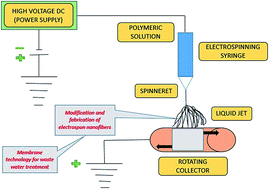A comprehensive review: electrospinning technique for fabrication and surface modification of membranes for water treatment application
Abstract
In this world of nanotechnology, nanofibrous structures offer specialized features, such as mechanical strength and a large surface area, which makes them attractive for many applications. Their large surface area to volume ratio also makes them highly efficient. Among all the techniques for generating nanofibers, electrospinning is an emerging and efficient process. Additionally, the electrospinning technique allows a uniform pore size, which is considered to be one of the important characteristics of membranes. Therefore, electrospun nanofibrous membranes have been used in water purification applications. Furthermore, the technique is widely utilized for generating membranes for membrane distillation and nanofiltration processes, for the removal of contaminants. However, in this review paper, more emphasis is given to the optimization of specific parameters and the preparation of polymeric solutions for fabricating specialized nanofibrous non-woven membranes, and surface modification for application in water treatment technology. Other issues, such as technology limitations, research challenges, and future perspectives, are also discussed.

- This article is part of the themed collection: Water treatment

 Please wait while we load your content...
Please wait while we load your content...